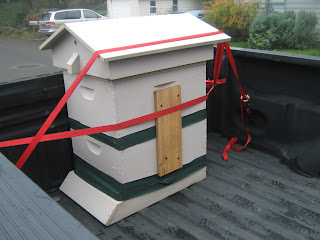Today one of our beehives was adopted by a new beekeeper because Jon received a job in West Virginia! We have been searching for a job closer to our families in Wisconsin and Minnesota so a move has been planned for about a year now. Work at the new office begins at the end of January so we are getting our home ready to sell and looking for a new place.
We have been discussing at length what to do with the bees in the event that we move. At first I thought I would put them in the back of a rented pickup and drive them across the country; but when I considered the resource use for transporting them and the time commitment, I figured it was probably best if they stayed here and I bought new ones wherever we went. I also didn't want to risk spreading diseases or exposing the colonies to new diseases (if disease exists which is hard to know sometimes without lab testing). There's no guarantee if they would even survive past spring since it's early winter, so a lot of work could be invested with a depressing result. So...I posted my hives on a bee list serve, Craigslist, and talked with a few friends. In only a few days I had a few bites. Here's how we transported the first hive:
Moving Bee Hives and Saying Goodbye
Posted by
Holly
on
Sunday, December 4, 2011
I shoved the entrance reducer in the opening as far as I could without it getting stuck in there. Then we wrapped a few layers of duct tape around the hive to hold the entrance reducer in place. The buyers were only transporting them about 4 miles away so there wasn't a concern of a lack of air flow. If the hives were being transported in the summer, then we would place window screening across the front. Both hives have screened bottom boards to help provide ventilation.
It was 34 degrees when the hive was moved. The hives haven't been opened since September so everything is sealed together really well with the bee propolysis. For added precaution, duct tape sealed the crack between the 2 boxes and boards were screwed on both sides to help keep the supers from shifting.
The hive was quickly loaded into the back of a truck and strapped down. Moving the hive was actually pretty simple. I think moving them in the winter when the population is small, the supers are sealed together really well, and the bees are less active is the best time of year to relocate a hive.
And now only one hive rests in the backyard waiting for the next owner. It is sad to look out my window and see the empty spot. I will never see that hive again, but I know that it is in good hands (see pic below). This is what happens when a move takes place----decisions must be made and the results are permanent. I am sad to part with my bees, my friends, our home, and all the fine details that have made our life here special. I will shed a few tears once the second hive is gone, our entire home is in a moving van, and last minute hugs are given away; but I continue to remind myself that life goes on and an adventure is out there waiting for us! Our family will find a country home with a perfect bee hive location and new faces will greet us. We will continue our homesteading adventures wherever we go and continue sharing it with our friends, family, and surrounding community.
This is where the hive now rests. It looks so cozy among the chickens in this suburban lot.
Labels: Bees









2 comments :
Good luck with your move!
I'm glad to hear you'll be getting more bees when you're all settled into your new home.
We look forward to seeing your new apiary!
HGTV Gardens just posted an article about moving bee hives and used a picture from this blog post!
Check it out: http://blog.hgtvgardens.com/bee-season-moving-the-hive/
Post a Comment